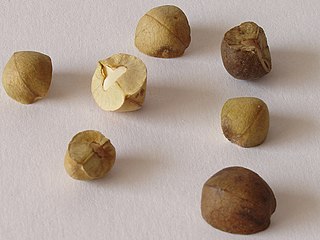
Mexican jumping beans are seed pods that have been inhabited by the larva of a small moth and are native to Mexico. The pod is usually tan to brown. They are from the shrub Sebastiania pavoniana, often also referred to as "jumping bean". However, they are not related to actual beans, but rather to spurges. The beans are considered non-toxic but are not generally eaten. In the spring, when the shrub is flowering, moths lay their eggs on the shrub's hanging seedpods. When the eggs hatch, tiny larvae bore into the immature green pods and begin to devour the seeds. The pods ripen, fall to the ground and separate into three smaller segments, and those segments are called Mexican jumping beans. As the tiny larvae inside curl up and uncurl, they hit the capsule's wall with their heads – and the bean jumps. They move more as temperatures rise, the larva eats away the inside of the bean and attaches itself to the inside of the bean with silk-like thread.
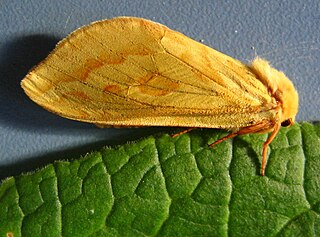
The ghost moth or ghost swift is a moth of the family Hepialidae. It is common throughout Europe, except for the far south-east.

The blotched emerald is a moth of the family Geometridae. The species was first described by Michael Denis and Ignaz Schiffermüller in 1775. It is found throughout Europe and the Near East. It has a scattered distribution in England and Wales, but is absent from Scotland and Ireland. In the southern Alps it rises up to 1000 metres.It is mainly found in oak forests.

The common emerald is a moth of the family Geometridae. The species is found throughout the Nearctic and Palearctic regions and the Near East. It is mostly commonly found in the southern half of the Ireland and Britain. It was accidentally introduced into southern British Columbia in 1973.

The swallow-tailed moth is a moth of the family Geometridae. The species was first described by Carl Linnaeus in his 1758 10th edition of Systema Naturae. It is a common species across Europe and the Near East.
A skiff is any of a variety of essentially unrelated styles of small boats, usually propelled by sails or oars. Traditionally, these are coastal craft or river craft used for work, leisure, as a utility craft, and for fishing, and have a one-person or small crew. Sailing skiffs have developed into high performance competitive classes. Many of today's skiff classes are based in Australia and New Zealand in the form of 12 ft (3.66 m), 13 ft (3.96 m), 16 ft (4.88 m) and 18 ft (5.49 m) skiffs. The 29er, 49er, SKUD and Musto Skiff are all considered to have developed from the skiff concept, all of which are sailed internationally.

Laothoe populi, the poplar hawk-moth, is a moth of the family Sphingidae. The species was first described by Carl Linnaeus in his 1758 10th edition of Systema Naturae. It is found throughout the Palearctic region and the Near East and is one of the most common members of the family in the region. It is distinctive due to its habit of resting with its hindwings held further forward than the forewings.

The grey dagger is a moth of the family Noctuidae.

The Moth is a small development class of sailing dinghy. Originally a small, fast home-built sailing boat designed to plane, since 2000 it has become an expensive and largely commercially produced boat designed to hydroplane on foils though many are still built at home, typically at much lower cost.

The 12 ft Skiff is a development dinghy class dating back to the early 20th century. It is sailed in Australia and New Zealand. It is 12 ft (3.7 m) in length, hence the name, and is a two-man boat. Both the crew and the helm are able to use the trapeze at the same time. It has an asymmetrical spinnaker and a jib, in addition to the mainsail.

The Limacodidae or Eucleidae are a family of moths in the superfamily Zygaenoidea or the Cossoidea; the placement is in dispute. They are often called slug moths because their caterpillars bear a distinct resemblance to slugs. They are also called cup moths because of the shape of their cocoons.

A mezcal worm is an insect larva found in some types of mezcal produced in Oaxaca, Mexico. The larva is a red maguey worm, the caterpillar of the Comadia redtenbacheri moth, usually called chinicuil or gusano rojo. The red worm is typically considered tastier than a white maguey worm.

The dryandra moth is a species of moth that is considered to be the sole member of the family Carthaeidae. Its closest relatives are the Saturniidae and it bears a resemblance to many species of that family, bearing prominent eyespots on all wings. The common name is derived from the Dryandra shrubs of the genus Banksia, on which the larva of this species feed, and is hence restricted to the south-west of Western Australia where these shrubs grow. Other Grevillea shrubs may also be used as host plants.

Metzneria paucipunctella is a species of moth known as the spotted knapweed seed head moth. It is used as an agent of biological pest control against noxious knapweeds, particularly spotted knapweed.
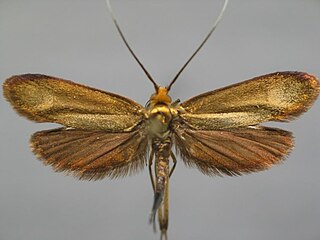
Nemophora metallica is a moth of the family Adelidae. It is found in Europe.

Phragmataecia castaneae, the reed leopard or giant borer, is a moth of the family Cossidae. It was described by Jacob Hübner in 1790. It is found in central and southern Europe, the Middle East, the Caucasus, Transcaucasia, Turkmenistan, Kazakhstan, north-western Iran, Iraq, Syria, Sri Lanka, Madagascar, India, Lebanon, Turkey, western China, south-western Siberia, Egypt, Tunisia and Morocco.

Glyphipterix simpliciella, the cocksfoot moth, is a species of moth of the family Glyphipterigidae.
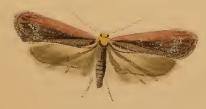
Blunt’s flat-body or purple carrot-seed moth is a moth of the family Depressariidae. It is found in most of Europe. It is also found in the Near East, North Africa, the eastern part of the Palearctic realm and since 2009 in North America. In the former USSR, it is distributed in the entire European part except for the Far North. It is also found in the northern Caucasus and Transcaucasia, in Kazakhstan, Central Asia, the south of Siberia, and the Russian Far East. It is an introduced species in North America, where it has been reported from Québec and Ontario.
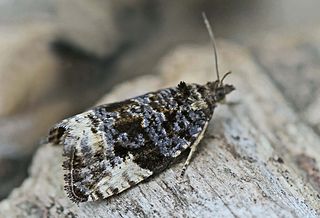
Hedya pruniana, the plum tortrix, is a species of moth of the family Tortricidae. It is found in the Palearctic realm. In central Europe, it is a common species. In the east, the range extends through Anatolia and Iran, the Ural, Transcaucasia and western Kazakhstan to the Far East.

Lymantria dispar dispar, commonly known as the gypsy moth, European gypsy moth, LDD moth, or North American gypsy moth or spongy moth, is a species of moth in the family Erebidae. It has a native range that extends over Europe and parts of Africa, and is an invasive species in North America.






















